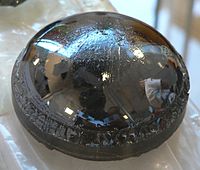
Photo from wikipedia
Abstract The development of new dopants makes a great contribution to the recent advances in organic semiconductors. In this work, a cyano-rich small molecule, i.e., octacyano[4]dendralene containing bis-1,1,4,4-tetracyanobutadiene unit (TCBD),… Click to show full abstract
Abstract The development of new dopants makes a great contribution to the recent advances in organic semiconductors. In this work, a cyano-rich small molecule, i.e., octacyano[4]dendralene containing bis-1,1,4,4-tetracyanobutadiene unit (TCBD), was used as a p-dopant of organic thermoelectric devices attributed to it being strongly electron-accepting and its high chemical stability. Poly(3,4-ethylenedioxythiophene) (PEDOT) was successfully doped by the TCBD dopant, and the degree of doping was comprehensively characterized by ultraviolet–visible–near-infrared (UV–Vis–NIR), Fourier transform infrared (FT-IR) spectroscopy, atomic force microscopy (AFM) images, ultraviolet photoelectron spectroscopy (UPS) and X-ray photoelectron spectroscopy (XPS) measurements. The PEDOT:TCBD complex achieved its best electrical conductivity and power factor when the TCBD concentration was 18 mol%. Furthermore, a practical thermoelectric generator was constructed by the combination of the p-type PEDOT:TCBD complex and n-type constantan.
Journal Title: Organic Electronics
Year Published: 2020
Link to full text (if available)
Share on Social Media: Sign Up to like & get
recommendations!